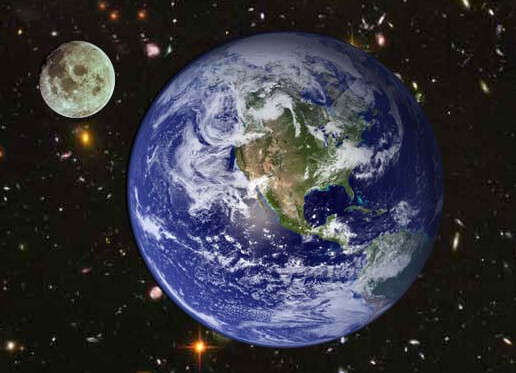A better defense of the Urantia Book's version of Earth-Moon Evolution
MORE ASTRONOMY / ARCHAEOLOGY / COSMOLOGY
- Architecture of the Universe and the Urantia Book
- Stars, Galaxies, Superuniverses and the Urantia Book
- Monmatia Revisited
- Earth-Moon Evolution
- A Tale of Two Orvontons
- Urantia, 606 of Satania
- Urantia, A Cosmic View of the Architecture of the Universe
- Jesus the Boatbuilder and the Ancient Boat
- Ancient Cyprus
- Did the Jews Really Not Bury Their Dead?
- Atlantis-Eden Parallels
- First Eden/Atlantis Analysis
by Phil Calabrese Ph D.

A careful reading of the Urantia Book's account of the earth-moon evolution reveals that the Urantia Book never says that the moon was once approximately equal in size to the earth, as claimed by Innerface International Editor Ken Glasziou. It must have started out more like a body with about 40% of earth's radius and therefore only 6% of earth's mass.
RECENTLY (Volume 11, Number 3, May/June 2004) and in earlier publications of Innerface International, alongside many good examples of the UB's seeming prophetic science, editor Ken Glasziou has also expressed the opinion that "the Urantia Book's account of the evolution of the earth-moon system is simply impossibly wrong." UB reader Norm Du Val recently asked me to look over this material, and another reader, Matthew Block, had earlier mentioned this moon-earth issue to me as well.
Ken apparently misinterprets the UB concerning the size of the moon as compared to the earth 2.5 billion years ago, and then he magnifies that misinterpretation into a great distortion of the real meaning and content of the UB's account. Ken even goes on to claim that the revelators purposely included the erroneous account in order to prevent people from idolizing the UB and thinking of it as infallible!
In my earlier effort (“A Defense of the Urantia Book’s Earth-Moon Evolution”) to provide a defense of the UB against such “time bomb” notions, I was overly influenced by Ken’s misinterpretation and therefore swallowed his interpretation that 2.5 billion years ago the moon was approximately the size of the earth. Even assuming Ken’s misinterpretation I was still able to avoid the conclusion of a “time bomb” in the UB but at the cost of changing a word (mass to size) in one place and by distinguishing between size and mass. Other remedies were also available. So a “time bomb” conclusion was never warranted even with the misinterpretation.
But consultations with long time reader and fellow scientist Stefan Tallqvist made me look again at the UB text and discover that the UB never really says what Ken claims. There are three paragraphs at issue:
1. "2,500,000,000 years ago the planets had grown immensely in size. Urantia was a well-developed sphere about one tenth its present mass and was still growing rapidly by meteoric accretion." (P. 658)
2."2,000,000,000 years ago the earth began decidedly to gain on the moon. Always had the planet been larger than its satellite, but there was not so much difference in size until about this time, when enormous space bodies were captured by the earth. Urantia was then about one fifth its present size." (P. 659)
3. "1,500,000,000 years ago the earth was two thirds its present size, while the moon was nearing its present mass.
Here is how Ken Glasziou interprets the first two paragraphs:
“The story that the revelators have given us is that our planet and its moon developed together from a meteoric cloud surrounding the sun by the process off co-accretion—and were approximately the same size until 2 billion years ago. At the -2.5 billion years mark we are told that the earth was one tenth its present mass. And since the revelators state the moon was about the same size as the earth at that time, it too, must have been about one tenth the present mass of the earth.”
Ken goes on with: “At the –2 billion years mark we’re told the earth and its moon were still about the same size, and by then, about one fifth the earth’s present mass.”
So three times in two paragraphs Ken asserts what is not really in the UB! Nowhere does the UB ever state that the moon was approximately the same size as the earth.
Ken’s misinterpretation of the moon’s size is quite understandable. The UB says that 2 billion years ago “the earth began decidedly to gain on the moon”. This tends to suggests that they were earlier “neck and neck” in an almost tie for size. Furthermore, the second clause of the next sentence, “but there was not so much difference in size until about this time, …” tends to suggest that the difference in sizes before this time was small. But it just says that the difference, whatever it was, was not “so” great as it became thereafter as the earth started to gather large masses to itself.
The UB says that the earth was always larger than the moon and that the difference between them started to become much greater about 2 billion years ago. The UB doesn’t say that they started out about the same size. The UB says, “Always had the planet been larger than its satellite, but there was not so much difference in size until about this time, ….” The UB does not say, “Always had the planet been larger than its satellite, but there was not much difference in size until about this time, ….” The only change between these last two sentences is that the later sentence does not include the two-letter word “so” that the UB has. That turns out to be an important little word that significantly changes the meaning when eliminated.
So with this greater freedom for the initial relative sizes of the earth and moon no distinction between mass and size is necessary to obtain a completely reasonable interpretation of the earth-moon evolution in the UB, and there is no error in the UB either.
Concerning the geometry of a sphere,
Volume (V) = (4/3) * Pi * (cube of the radius R)
Mass (M) = Density * V
So M = Density * (4/3) * Pi * R**3
= K * R**3, where K is some constant.
If M1 and M2 are two masses of two bodies of corresponding radii R1 and R2, then
(M1/M2) = K * R1**3 / (K * R2**3) = (R1/R2)**3.
And so solving for (R1/R2),
(R1/R2) = (M1/M2)**(1/3), the cube root of (M1/M2).
(R1/R2) is also the ratio of the diameters of the spheres.
So in comparing two bodies, if one body is 30% greater in radius (or diameter) than the second body, i.e., the ratio of the radius of one to the radius of the other is 1.3, then the larger body will have roughly (1.3)*(1.3)(1.3) = 2.2 times the mass of the smaller body.
(Again, this assumes bodies of equal density, which is a good enough approximation for explaining factors of error of 8 and 16 supposedly contained in the UB's account.)
On the other hand, if the mass of the first body is 1/10 the mass of the second body, then the first body will be approximately the cube root of (1/10) larger in radius than the second body. The cube root of 1/10 is about 0.46. So the first body would be almost half the second body in size while only 1/10 its mass.
* * *
Facts about the earth and moon quoted by Ken Glasziou:
Present mass of the earth = 5.94 x 10**21 metric tons
Present radius of earth = 6378 km.
Present mass of the moon = 7.5 x 10**19 metric tons
Present radius of moon = 1738 km.
***
So the earth is now about (6378/1738) = 3.670 times the moon in radius, and the earth is now (5.94 x 10**21 / 7.5 x 10**19) = (5.94/7.5) * (10**2) = 79.2 times the moon in mass.
Interpretation of the UB’s account:
In 1., the UB says that the earth was 1/10 its present mass
Mass_Earth_2.5B = (1/10) Mass_Earth_Now
So by the earlier number example,
Radius_Earth_2.5B = 0.46 Radius_Earth_Now
By this implication, the UB is saying in affect that 2.5 billion years ago the earth’s radius was almost half its present radius.
That description is also supported by the UB’s saying that 2.5 billion years ago “Urantia was a well-developed sphere….”
Having more freedom for the size of the moon, we can suppose that the moon was, say, 2/5 or 40% of earth’s radius 2.5 billion years ago. So
Radius_Moon_2.5B = 0.40 * Radius_Earth_2.5B
= 0.40 * 0.46 * Radius_Earth_Now
= 0.18 * Radius_Earth_Now
So the moon would have had a radius of 18% that of the earth at present. That percentage is less than its present percentage of about 1738/6378 or about 27%, which is reasonable since the moon continued to gain in size by capture of meteors.
Mass_Moon_2.5B = (Cube of 0.40) * Mass_Earth_2.5
= 0.064 * Mass_Earth_2.5
= 0.064 * (1/10 of Mass_Earth_Now)
= 0.0064 Mass_Earth_Now
So in that case the moon would have a mass of about 0.064 or 6.4% of earth’s mass at that time, and so it would have 1/10 of that or 0.64% of earth’s mass now. That’s less than 1% of earth’s present mass. The moon now has 1/79.2 or 1.26% of the earth’s mass. So this is reasonable.
Then in paragraph 2., the UB says that after another half billion years the earth had grown to 1/5 its present size. Since size here is proportional to mass and to volume,
Mass_Earth_2B = (1/5) Mass_Earth_Now
So
Radius_Earth_2B = (Cube root of 1/5) * Radius_Earth_Now
= 0.58 Radius_Earth_Now
So the earth had 58% of its present radius at that time, which seems reasonable.
Concerning the moon, it might have lost a little relative size and become only about 35% of the earth’s size and mass at that time. So in that case
Radius_Moon_2B = 0.35 * Radius_Earth_2B
= 0.35 * 0.58 * Radius_Earth_Now
= 0.20 * Radius_Earth_Now
So the moon would have had 1/5 or 20% of earth’s radius then. It presently has 27%. So that’s a reasonable value.
Mass_Moon_2B = (Cube of 0.35) * Mass_Earth_2B
= 0.043 * Mass_Earth_2B
= 0.043 * (1/5 of Mass_Earth_Now)
= 0.0086 Mass_Earth_Now
This is still about 32% less than the present mass of the moon, which is 0.0126 of earth’s present mass. So that seems reasonable.
Mass_Earth_1.5B = (2/3) Mass_Earth_Now
So
Radius_Earth_1.5B = Cube root of (2/3) * Radius_Earth_Now
= 0.87 Radius_Earth_Now
So the radius of the earth then was about 87% of its present radius. That also seems reasonable.
Mass_Moon_1.5B = Mass_Moon_Now = (1/79.2) Mass_Earth_Now.
But Mass_Earth_Now = (3/2) Mass_Earth_1.5B
So Mass_Moon_1.5B = (1/79.2)*(3/2) Mass_Earth_1.5B
= 0.019 Mass_Earth_1.5B
= 1.9% of Mass_Earth_1.5B
So 1.5 billion years ago the mass of the moon was about 1.9% of the mass of the earth. This seems about right because the earth continued gaining in relative mass on the moon during the intervening 1.5 billion years so that it is now 79.2 times the moon in mass not just 52 times the moon’s mass.
Concerning radius,
Radius_Moon_1.5B = Radius_Moon_Now = (1/3.67) Radius_Earth_Now
And Radius_Earth_Now = (Cube root of 3/2) * Radius_Earth_1.5B
So Size_Moon_1.5B = (1/3.67)* (Cube root of 3/2) * Radius_Earth_1.5B
= (1/3.67)*(1.145)* Radius_Earth_1.5B
= 0.31 Radius_Earth_1.5B
So at that time the moon was about 31% the radius of the earth compared to only about 27/100 = 27% of earth's radius now. But that is about right because the earth continued to gain matter while the moon didn't gain much after that.
|
|
|
|
|
|
|
|
|
|
|
|
|
|
|
|
|
|
|
|
|
|
|
|
|
|
|
|
|
|
Table 1. Relative Earth and Moon Radii and Masses over Time
So we see that there is nothing essentially wrong with the UB's account of the earth-moon evolution that a careful reading can’t dispel.
(Note that by the formula being used above a size ratio of 3.67 should roughly correspond to a mass ratio of 3.67 cubed, or 49.4. That the earth has even larger mass ratio over the moon is due to earth's somewhat greater density because of more gravity packing the matter together and also heavier matter in the earth.)
So those who think that errors were purposely included in the UB will have to look elsewhere to make their case.
[Aside: The idea that errors were purposely included in the UB by the Revelators to prevent Book idolatry - to prevent belief in the infallibility of the Urantia Book - is quite insidious to the long term human belief and faith in the authenticity of the UB as actual divine revelation. That is not the intention of those promoting this "time bombs" notion; but I think it is a subtle, unrecognized implication because it really discredits the Revelators as divine truth tellers.
Frankly, this notion that the Revelators resorted to purposely telling us falsehoods to prevent book idolatry greatly underestimates their ability to deter such Book worship by employing the truth. Instead of "time bombs", the Revelators decided to leave in the human transcription errors that they knew about. They also mentioned some scientific oversimplifications that would need updating in a "few short years". These self-qualifications should have been enough to ensure a healthy skepticism of anything written in the UB without overly discounting the UB as divine revelation.
The Revelators also included rather implausible or embarrassing facts like "Mighty Messengers", 50-foot wing span human transport birds (which are aerodynamically possible, "racial inferiority", and angelic speeds of three times that of light. These things do not need to be false to discourage Book idolatry. It is rather because people find them hard to believe that they have entertained the idea that they are false and were purposely included to prevent Book idolatry.
But we should not forget that every divine revelation, including the UB, requires some faith, not just reason. Were scientists unable to witness it, they would tend not to believe that caterpillars could metamorphose into butterflies, or that words and pictures could be sent across great distances almost instantly over invisible "electromagnetic waves".
There is always reason to believe more than we can scientifically prove.
That is my claim in view of K. Gödel’s Incompleteness Theorem. (The Incompleteness Theorem essentially says that any language that contains the counting numbers has statements that are true but which cannot be proved true using only words in the language in which that statement was made. Only a richer language can prove the statement, but that richer language has its own unprovable statements.)
Phil Calabrese is a retired professor of mathematics, past aerospace engineer, a retired research mathematician for the US Navy, and owner of Data Synthesis. He is also a long-time Urantia Book reader.

